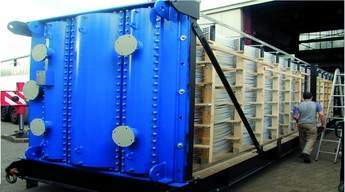The German engineering firm Wallstein has developed and delivered two heat recovery systems to the Belchatow plant, in Poland, but constructed from PTFE elements instead of the more usual nickel alloys. The net result is to prolong the life of the heat exchanger and thereby improve the availability of the plant.

Wallstein Ingenieur GmbH in Recklinghausen has developed and delivered two heat recovery systems for Europe’s largest power station, Belchatow, in Poland, operated by PGE Elektownia Belchatow SA. The plant is to be expanded by the addition of an 858 MW block, for which the general contractor is Alstom, which has a projected efficiency of around 42%. To help achieve this efficiency level the power station employs a Wallstein heat recovery system which increases the net efficiency of the plant by 0.65 percentage points. The system unit, one for each of two lines, consists of a number of PTFE heat exchanger elements which cool the boiler flue gas by around 50K and export around 32MW per complete unit to a boiler feed water heater (Figure 3). This reduces the turbine steam bleed required, thereby increasing the electrical output.
The PTFE tubing is constructed from AlWaFlon®, a development of DuPont’s Teflon®, and the total length of tubing in each heat exchanger is around half a million metres.
The net result of employing AlWaFlon tubing is expected to be a lengthening of the life of the heat exchange installation and an improvement in the life and availability of the power station.
Construction of the heat exchanger
AlWaFlon is a proprietary development from Wallstein Ingenieur GmbH in Recklinghausen, Germany, Fluortubing in Utrecht, the Netherlands, and DuPont in Switzerland. The chemically inert fluoropolymer is mixed with specific materials in order to produce a tube that has optimal characteristics for heat transfer, strength and temperature endurance. It is also used to line the heat exchanger casing.
The industry has long been dominated by nickel-alloy products, which have good temperature and pressure characteristics but in some instances cannot withstand the corrosive effects of the flue gas. Flue gas can contain aggressive acidic mixtures of SO2, SO3, HF and HCl, which condense out of the gas at their dewpoint temperatures and attack metallic material with which they come into contact. AlWaFlon is not affected by this corrosive acid mixture and its non-stick Teflon-like characteristic also means that flue gas does not adhere to the surface of the polymer. This is not the case with metal tubing, where corrosive fluids attach to the outer surfaces of the tubes and further corrode the metal. Besides its use in coal fired power stations, where gas/water heat exchangers are fitted, the piping is also employed in gas/gas heat exchangers for incinerators, and in condensing economisers for biomass power plants, as well as industrial boilers where dewpoint corrosion is a major issue.
Wallstein uses a unique flexible spacer system to ensure that the thermal expansion of the tubes is freely accommodated, and that they are corrosion-proof, and easily washed. The washing system employed minimises the dust build-up in the system, ensuring that system performance is not affected by undue accumulation. Wallstein also designed the piping system for the hydronic circuit and the control circuitry for the system.
Testing
In proof tests from BASF, AlWaFlon withstood high pressure and temperature for over 10 000 hours, at a higher temperature than other fluoropolymers. This allows the wall thickness to be reduced and the thermal performance of the tube to be increased. The notified body, TÜV Süd, has tested the pressure tubes and reported positive results with higher temperatures. The upper temperature limit for this material is around 260°C, depending on the tube pressure.
